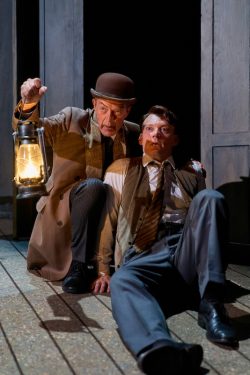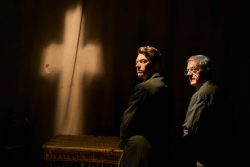 IF you have seen The Woman in Black before – and after 33 years in the West End and 11 national tours, many thousands of us have – you will know that it is absolutely terrifying. You can keep your Nightmares on Elm Street or Blair Witch Projects – Susan Hill’s chilling novel, adapted brilliantly by Stephen Mallatratt, is a real shudders-down-the-spine, hair-raising, cold, creepy, horror story.
IF you have seen The Woman in Black before – and after 33 years in the West End and 11 national tours, many thousands of us have – you will know that it is absolutely terrifying. You can keep your Nightmares on Elm Street or Blair Witch Projects – Susan Hill’s chilling novel, adapted brilliantly by Stephen Mallatratt, is a real shudders-down-the-spine, hair-raising, cold, creepy, horror story.
It starts so oddly – a bare stage, an old man with a briefcase reading from a journal, a much younger actor trying to inject some life and interest into the man’s monotone and eventually the two finding a voice together to tell the old man’s story. And so it begins …
I first saw The Woman in Black not long after its debut at Alan Ayckbourn’s Scarborough theatre. The play was staged at Bristol Old Vic – the country’s oldest theatre in continuous use, which famously is haunted. The right place to see a ghost story. We thought it was so powerful that I took my daughter and a school-friend (who had never been to the theatre). When the loudest and most spine-tingling of the screams rang through the ancient playhouse, the poor girls all but jumped out of their skins.
So here it is, back at Bath Theatre Royal, one of the old theatres in which director Robin Herford says the play works best, and the big question is – does it still work?
Even if you have seen it, do you remember all those telling little details, do you actually know where the screams will come, are the sound effects still so convincing that you can believe you are lost in a swirling East Coast sea-fret with the water lapping at your feet and a horse and cart with its passengers sucked into the treacherous marsh?
Close your eyes as Arthur and Kedwick the Carter cross the causeway to Eel Marsh House and you hear the seabirds, the clip-clop of the horse’s hooves and the rattle of the old cart.
Herford still re-directs every new cast or tour of the play he commissioned and first directed at Scarborough all those years ago. That gives this powerful drama its authenticity and resonance, but each new cast of two changes the dynamic slightly and each theatre has its own atmosphere.
 I went with a blind friend to see this latest tour, with Malcolm James as Arthur Kipps the old solicitor, and Mark Hawkins as The Actor. I described the minimal set to her and whispered the odd image or moves that she couldn’t see, but otherwise it was all down to the actors and to those marvels of sound technology.
I went with a blind friend to see this latest tour, with Malcolm James as Arthur Kipps the old solicitor, and Mark Hawkins as The Actor. I described the minimal set to her and whispered the odd image or moves that she couldn’t see, but otherwise it was all down to the actors and to those marvels of sound technology.
In addition to the great story-telling, acting and use of theatrical sound and light, the play has several clever psychological tricks – it taps into our peculiar enjoyment of being scared, it tells a heart-breaking story of separation, loss, death and vengeance, raw human emotions that we can all relate to.
But the over-riding reason why The Woman in Black works is, of course, the collective experience. As the weird atmosphere of the lonely ancient house on its marshy island begins to creep into our bones, we begin involuntarily to shiver – the vicious east winds are almost as chilling as the creepy sounds in the house and the sea fret makes our flesh crawl. We are only too ready to be scared witless when the eerie scream echoes around the theatre …
If you have never seen this most effective and brilliantly imagined horror story on stage (it is most definitely more involving and frightening on stage rather than on screen), don’t miss it at Bath Theatre Royal, where it continues to Saturday 16th March.
So – does it still work? You bet. Just ask my blind friend.
FAC
Photographs by Mark Douet